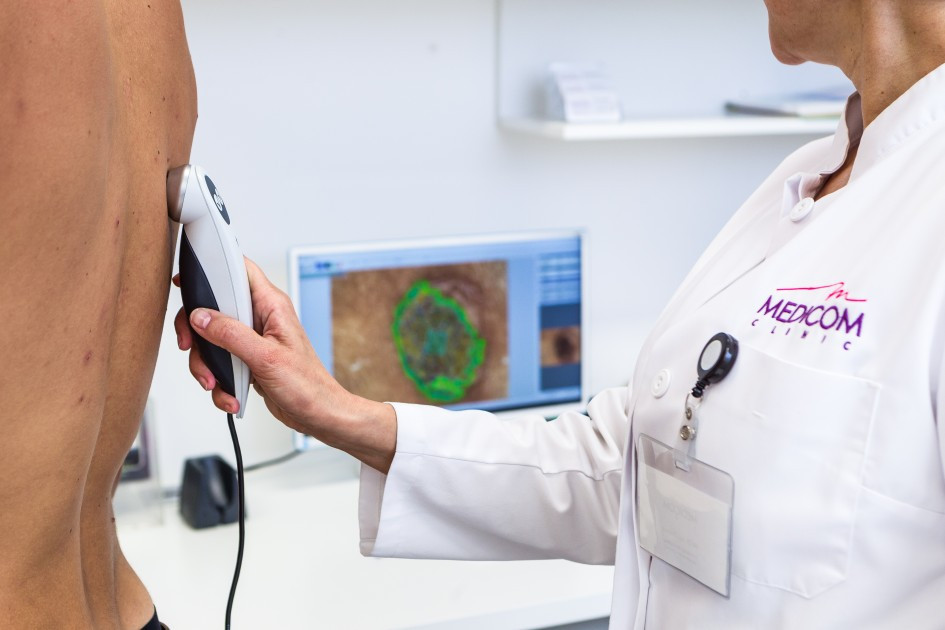Healthy skin is beautiful skin - make sure you get a preventive mole check

Freckles on the body can vary in size, shape and colour. They all deserve professional and thorough attention, even the smallest of them. The month of May is dedicated worldwide to the prevention of skin cancer, which has unfortunately been on the rise in recent years. Dermatologists therefore recommend making sure to get annual check-ups.
The mole has started to change, what to look out for?
Recognising a skin tumour early is key to successful treatment. Regular self-examinations should therefore be included in mole care alongside visits to the dermatologist. You should look for the following factors:
- Change in size, shape or colour of moles
- New or unusual formations on the skin
- Unusual itching, bleeding or soreness
- Uneven margins or irregular shape
- Rapidly enlarging mole
"In particular, pigmented lesions enlarged over 5 mm or moles raised above the skin level are suspicious. It is also important to watch for changes in the colour of the mole. Most often, it is darkening, reddening, irregular distribution of pigment or the formation of irregular margins."
Who should be especially careful of moles?
Skin tumours are unpredictable to some extent and can affect virtually anyone, but there is a group of people at higher risk who should be particularly cautious. These include people with:
- Fair skin that burns easily in the sun
- A history of sunburn in childhood or adulthood
- Frequent and prolonged exposure to the sun
- Regular visits to a tanning salon
- More than 50 moles
- Family history of skin tumours
- Age over 50 years
It helps to know your phototype well
Distinguishing your skin's phototype is crucial for proper sun protection. "For low phototypes with more moles or a positive family history, I recommend checking moles at least once a year. However, I highly recommend coming in right away in case of any change or discovery of a new pigmentation," explains corrective dermatologist Markéta Majerová, MD.
Phototype I
Has fair skin, often with freckles. Hair is usually blond or rusty. Eyes are most often light - blue or green. The skin is extremely sensitive to sunlight, almost always burns and never tans to a dark tone.
Phototype II
Also has light skin, but slightly darker than phototype I. Hair is usually blond or dark blond. The eyes tend to be blue. The skin is also sensitive to sunlight, rarely tans and is prone to sunburn.
Phototype III
Characterized by light brown skin color, with dark blond or brown hair. Eye color may vary, but skin is moderately sensitive to sunlight, tans easily and quickly, and the tan lasts a long time.
Phototype IV
Characterized by light to dark brown skin, usually brown or black hair, and dark eyes. This skin type rarely burns, tans easily, and the tan lasts a long time. In terms of risk, this phototype is least likely to develop melanoma.

Quick and painless dermatoscope examination
Our dermatologists use a digital dermatoscope to check moles, which is a special magnifying glass-like device that magnifies each mole many times. This makes the evaluation of skin formations easier for the doctor. This device can also perform an automatic analysis and store the results, allowing the doctor to compare the appearance of the mole with previous inspections and to see how the pigmentation changes over time.
If we find that any of your moles may be dangerous during the check-up, there are various treatment options. Irregular pigmented nevi can be excised and sent for histology. Growths and some intradermal nevi are then removed with an erbium laser, which precisely vaporizes the growth layer by layer. The skin will heal over the stroma without scarring. This procedure allows removal of dangerous skin formations with minimal risk of complications and ensures that the skin heals without scarring.
Are you thinking about having a procedure at our clinic?
Make an appointment for a no-obligation consultation with an experienced doctor.